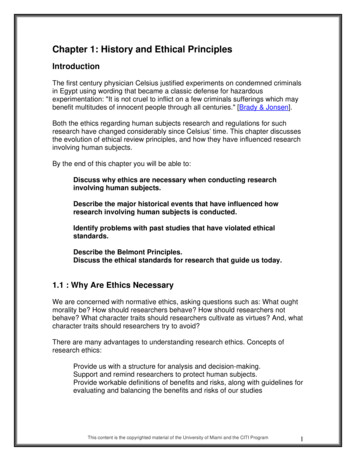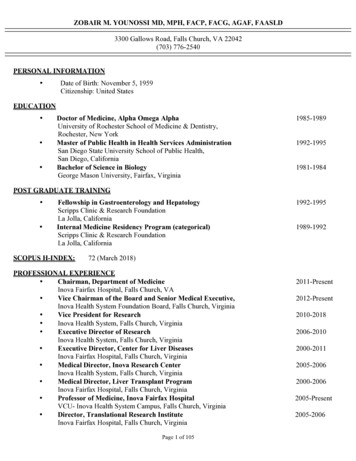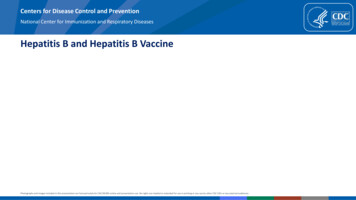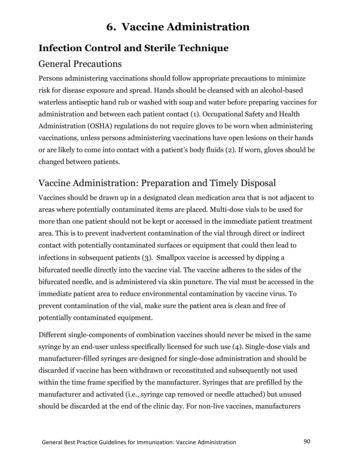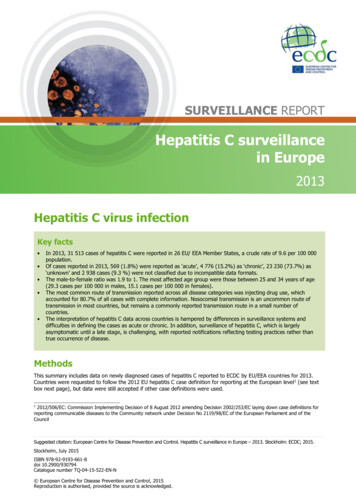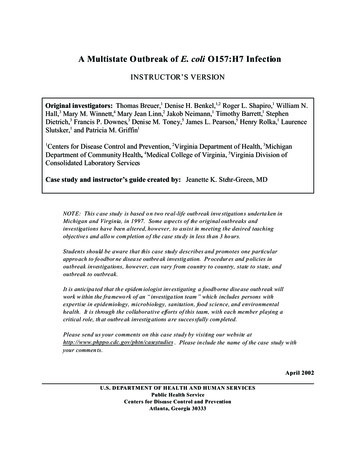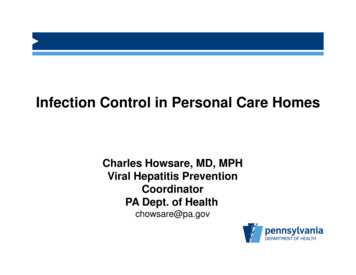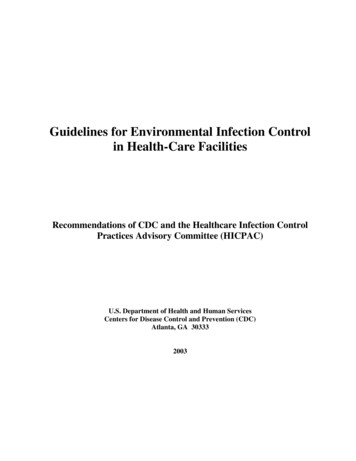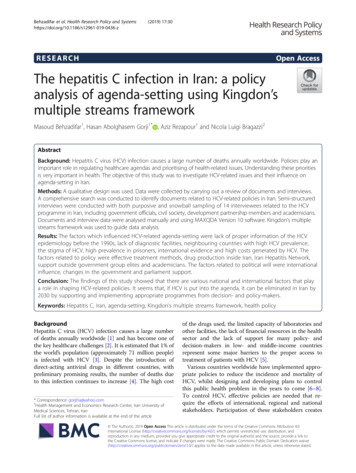
Transcription
Behzadifar et al. Health Research Policy and 019) 17:30RESEARCHOpen AccessThe hepatitis C infection in Iran: a policyanalysis of agenda-setting using Kingdon’smultiple streams frameworkMasoud Behzadifar1, Hasan Abolghasem Gorji1* , Aziz Rezapour1 and Nicola Luigi Bragazzi2AbstractBackground: Hepatitis C virus (HCV) infection causes a large number of deaths annually worldwide. Policies play animportant role in regulating healthcare agendas and prioritising of health-related issues. Understanding these prioritiesis very important in health. The objective of this study was to investigate HCV-related issues and their influence onagenda-setting in Iran.Methods: A qualitative design was used. Data were collected by carrying out a review of documents and interviews.A comprehensive search was conducted to identify documents related to HCV-related policies in Iran. Semi-structuredinterviews were conducted with both purposive and snowball sampling of 14 interviewees related to the HCVprogramme in Iran, including government officials, civil society, development partnership members and academicians.Documents and interview data were analysed manually and using MAXQDA Version 10 software. Kingdon’s multiplestreams framework was used to guide data analysis.Results: The factors which influenced HCV-related agenda-setting were lack of proper information of the HCVepidemiology before the 1990s, lack of diagnostic facilities, neighbouring countries with high HCV prevalence,the stigma of HCV, high prevalence in prisoners, international evidence and high costs generated by HCV. Thefactors related to policy were effective treatment methods, drug production inside Iran, Iran Hepatitis Network,support outside government group elites and academicians. The factors related to political will were internationalinfluence, changes in the government and parliament support.Conclusion: The findings of this study showed that there are various national and international factors that playa role in shaping HCV-related policies. It seems that, if HCV is put into the agenda, it can be eliminated in Iran by2030 by supporting and implementing appropriate programmes from decision- and policy-makers.Keywords: Hepatitis C, Iran, agenda-setting, Kingdon’s multiple streams framework, health policyBackgroundHepatitis C virus (HCV) infection causes a large numberof deaths annually worldwide [1] and has become one ofthe key healthcare challenges [2]. It is estimated that 1% ofthe world’s population (approximately 71 million people)is infected with HCV [3]. Despite the introduction ofdirect-acting antiviral drugs in different countries, withpreliminary promising results, the number of deaths dueto this infection continues to increase [4]. The high cost* Correspondence: gorjiha@yahoo.com1Health Management and Economics Research Center, Iran University ofMedical Sciences, Tehran, IranFull list of author information is available at the end of the articleof the drugs used, the limited capacity of laboratories andother facilities, the lack of financial resources in the healthsector and the lack of support for many policy- anddecision-makers in low- and middle-income countriesrepresent some major barriers to the proper access totreatment of patients with HCV [5].Various countries worldwide have implemented appropriate policies to reduce the incidence and mortality ofHCV, whilst designing and developing plans to controlthis public health problem in the years to come [6–8].To control HCV, effective policies are needed that require the efforts of international, regional and nationalstakeholders. Participation of these stakeholders creates The Author(s). 2019 Open Access This article is distributed under the terms of the Creative Commons Attribution 4.0International License (http://creativecommons.org/licenses/by/4.0/), which permits unrestricted use, distribution, andreproduction in any medium, provided you give appropriate credit to the original author(s) and the source, provide a link tothe Creative Commons license, and indicate if changes were made. The Creative Commons Public Domain Dedication o/1.0/) applies to the data made available in this article, unless otherwise stated.
Behzadifar et al. Health Research Policy and Systems(2019) 17:30a high political commitment and mobilises all resourcesto implement these policies [9, 10].Advocacy in HCV control programmes has led toachievement of effective patient treatment and management goals as well as a reduction in the costs of medicinesthrough the establishment of pharmaceutical companies toproduce medicines locally overcoming the need to buythem from third countries [2]. Additionally, advocacy ofthe country’s stakeholders is an important and vital elementintegral to healthcare policy [11]. To prevent, control andcure a disease, new policies need to be implemented orexisting policies must be changed [12], both of which arevery complex policy processes [13]. Policy- and decisionmakers decide on the various issues affecting the healthsector, including the amount of personal interest, the magnitude of the topic, the available scientific evidence, politicaland social considerations, the efforts of interest groups andtheir impact on the topic. All these issues can influence thedecision of health policy- and decision-makers of whetherto place a topic on their agenda [14]. Thus, various factorscan impact on the process of agenda-setting and should betaken into consideration [15].Existing policies to control HCV can accelerate theprocess of reducing, and even eliminating, its burden ifthey are taken seriously by policy- and decision-makersand put on their agenda [16]. When a major issue, suchas HCV, is put into action, comprehensive support forthe issue will make policies work properly; thus, the roleof policy- and decision-makers in the success or failureof an important policy is of crucial importance [17]. Foran issue like HCV to become a priority, complex processes are undertaken; the priority of a policy orprogramme is defined by the degree of policy- anddecision-makers’ attention to financial, human, and technical issues and resources that can be used or mobilisedto implement that policy [18].HCV in Iran is an important public health challengeand should be addressed by health policy- anddecision-makers. Despite the low prevalence of HCV inthe general Iranian population, the infection is on the rise[19]. It is expected that, in the near future, this infectionwill be the most important cause of deaths related tohepatitis in Iran [20]. Its high prevalence is particularlyalarming in high-risk groups such as injecting drug users(IDUs) and prisoners [21, 22]. Undoubtedly, HCV shouldbe placed on policy- and decision-makers’ agenda. Policiesplay a vital role in health issues related to communityhealth, and therefore understanding the relevant factors that can impact on the process of agenda-settingis very important.The present investigation aimed to better understandHCV-related issues and their impact on policies in Iran.To achieve this, Kingdon’s multiple streams frameworkwas deemed suitable for the purpose and, as such, wasPage 2 of 10selected for this study. This framework is an appropriatetechnique for the planned analysis in that it enables theexploration of HCV-related issues and the effects theyhave on the process of agenda-setting. Being this thefirst analysis on HCV-related issues and their impact onpolicies in Iran, the investigation was conducted at amacro-level (national level), rather than focusing on asingle region or province.The theoretical frameworkKingdon’s multiple streams framework is one of themost used conceptual tools for understanding theprocess of policy-making, including policies in the fieldof healthcare. This instrument enables scholars to capture the different steps of the policy-making process,including how policies are developed and implementedand which are the obstacles (lack of interest, lack ofclarity and ambiguity, among others) that hinder thefull implementation of a given policy. In detail, Kingdon’s framework includes three elements or independent streams. Providing appropriate conditions for aninteraction among these three issues will cause opportunities to be created and will facilitate the process ofagenda-setting by policy- and decision-makers [23]. Aspreviously mentioned, this framework can be used toexplain how different policies have addressed varioustopics in the health sector [24–32].One of these streams is the ‘problem’ stream. Thisstream includes indicators, focusing events or feedbackmechanisms. Indicators include issues that health policyand decision-makers, researchers, doctors, and otherstakeholders can achieve in their daily routine monitoringactivity or scientific research. Policy- and decision-makerscan use these indicators to determine the impact of a topicand evaluate different scenarios about them. Some examples of these indicators include the outbreak of a disease,the rate of death from road accidents, the shortage ofmanpower and increased healthcare costs. Focusingevents such as a tragedy, a crisis or a disaster can triggerpolicy- and decision-makers’ feedback on a given issue.Many indicators alone cannot determine the importanceof an issue, which is rather given by the complex interactions among indicators. Within Kingdon’s framework, several actors, such as government officials, the media,interest groups, industries, legislators and constituents, aswell as other stakeholders, play a major role.The second of Kingdon’s streams is the ‘policy’ stream.This stream involves potential solutions to the problemand allows individuals and groups to work on a solutionto further develop it. Actors involved in this process caninclude lawmakers, special interest groups, policy entrepreneurs, professionals, academicians and industry researchers. These people can provide different alternativesor problems, issues and situations in order to influence
Behzadifar et al. Health Research Policy and Systems(2019) 17:30the process of agenda-setting. Factors such as the levelof support for individuals and groups, costs, industriesand past experiences can also influence the choice ofalternatives.The final stream in Kingdon’s model is the ‘political’stream. National mood, shifts in administration, mediainfluence, interest group advocacy campaigns, electionsand ministerial changes can have an impact on the processof policy- and decision-making. In addition, legislatorsand administrators also have an influence on politicalprocesses.Based on Kingdon’s model, the interaction of these threestreams determines the process of agenda-setting. Policiesare implemented effectively when all of these streams converge, resulting in a policy window. Policy entrepreneurscan facilitate this process and create opportunities for policy progress. As previously stated, the aim of this studywas to investigate the determinants of the process ofagenda-setting of HCV-related issues in Iran.MethodsData collectionData were collected by carrying out a comprehensive review of relevant HCV-related documents and interviews.Document analysisA comprehensive search was conducted to identify documents related to HCV issues and policies, contained inscholarly publications as well as in the grey literature inIran. The websites of the different pertinent ministriesand related organisations, such as the Ministry of Healthand Medical Education (MoHME), the Parliament (Majlis), the Iranian Judicial system, the Ministry of Cooperatives, Labour and Social Welfare, the State Prisons andSecurity and Corrective Measures Organisation, the RedCrescent, the Imam Khomeini Relief Foundation, andthe Ministry of Sport and Youth, were consulted.Additionally, scholarly databases, including PubMed/MEDLINE, ISI/Web of Science, EMBASE and Scopus,were searched from January 1990 up to July 2018, usinga string of keywords related to the topic under study.Google Scholar was used to retrieve the grey literature.Concerning the search strategy, the following keywordswere selected: (policy OR policies OR plans OR programs OR strategies OR solutions) AND (‘hepatitis Cvirus’ OR ‘viral hepatitis’ OR HCV) AND Iran.National guidelines, training manuals and handbooks,health reports, national health plans, international, nationaland regional policies, health protocols, non-governmentalorganisation (NGO) reports, and HCV-related laws werealso searched; this search was done independently by twoauthors in order to identify all documents.Page 3 of 10Semi-structured interviewsSemi-structured interviews were conducted with bothpurposive and snowball sampling of 14 interviewees related to the HCV programme in Iran, including government officials, civil society, development partnershipmembers and academicians. These people were involved in the planning, decision-making, policy-makingand support of HCV programmes.Interviews were digitally recorded and saved using atape recorder. During the interview, a handwrittennote was also prepared. The interview time was between 45 and 70 min. Interview data accuracy wasachieved by reviewing the handwritten texts by interviewees and using their complementary comments aswell as involving well-trained researchers in theprocess. In addition, two experts in the field of qualitative studies monitored the whole interview process.The use of an integrative method, including note-taking during interviews and a sampling method ensuringmaximum diversity, provided data reliability andtransferability [33].With regards to policies concerning HCV, the following questions were asked:1. Problem stream: What challenges still unresolvedand unaddressed make HCV a problem in Iran?2. Policy stream: What solutions have been found andadopted by individuals or groups to addressHCV-related issues in Iran?3. Political stream: What are the political factors thatcan influence the effective adoption of HCV-relatedpolicies in Iran?Analytical approachData extracted from documents and interviews wereanalysed both manually and using MAXQDA Version 10software for content analysis. Following familiarisationwith the data and a preliminary analysis of the interviews, initial codes were prepared and, after removingthe same duplicate codes, they were interpreted and finally assigned under the themes of Kingdon’s multiplestreams framework (problem, policy and politicalstreams). The principles of content analysis were appliedto guide and inform the data analysis.EthicsWritten, informed consent was obtained from each participant after a clear and thorough explanation of thestudy objectives and assurance of the confidentiality ofone’s own identity. Ethical approval for this study wasobtained from the authors’ institute prior the commencement of the investigation.
Behzadifar et al. Health Research Policy and Systems(2019) 17:30ResultsAccording to Kingdon’s framework, the effective factorsassociated with HCV-related issues and policies, whichcan be described as a priority in Iran, can be analysed andsubdivided into the problem, policy and political streams.Problem streamLack of proper information on HCV before the 1990sThe participants stressed that, until the 1990s, there wasnot enough information on HCV in Iran concerning thenumber of patients with HCV and the epidemiologicaland clinical burden of the disease. Indeed, no attentionwas paid to this disease, and remained inadequately addressed by the healthcare departments and institutions.Only after the advent of contaminated blood, HCVbegan to be considered as an issue by policy- anddecision-makers.Diagnostic facilitiesThe respondents stated that, in the same years, laboratory facilities were limited in their ability to diagnosethe disease due to the costs, and therefore many peoplewere not able to identify their illness due to lack ofdiagnostic facilities.Neighbouring countries with high prevalence of HCVThe participants stated that the prevalence of HCV inIran is lower than in its neighbouring countries, such asIraq, Afghanistan, Pakistan, Turkey, Azerbaijan andTajikistan, which have a high HCV prevalence rate. Themovement of people from these countries to Iran, especially those at a higher risk, could cause the transmissionof new cases.Transit from Afghanistan and increased number of addictsThe respondents declared that Afghanistan, the largestproducer of narcotics in the world and one of Iran’sneighbouring countries, is one of the main traffickingroutes. Hence, the number of IDUs in Iran has increasedand, according to the available scientific evidence, theprevalence of HCV among these individuals is high andhas raised serious concerns.Page 4 of 10High HCV prevalence in prisonersThe respondents stressed that the various studies haveshown that HCV levels in prisoners are higher than inother populations in the community. The high-risk behaviours that exist in prisons can provide the basis forthe high prevalence of this disease. On the other hand,prison officials, for various reasons, are not willing tocooperate fully with diagnostic and therapeutic procedures, and they have problems with providing prisonerswith syringes.International evidenceThe participants stated that, in its 2017 report on hepatitis, WHO announced that the Middle Eastern region,including Iran, has a low-moderate HCV prevalence, except for some areas with high levels of HCV infection.However, according to this report, the death rate fromhepatitis has increased between 2005 and 2015, and isalarmingly high for Iran.High costs of HCVThe respondents stressed that the costs generated byHCV treatment and management are high and many patients are not able to pay for them. The MoHME’s funding for this disease is limited and therefore the lack ofattention to these patients causes serious problems forthem and other people in the community. The MoHMEalone cannot afford all HCV-related costs. If patients arenot supported, they will avoid treatment, causing manypeople at risk of contracting HCV to actually contract it.Increased HCV in IDUsIDUs are considered worldwide as one of the most important high-risk groups for HCV infection. They represent an alarming issue for all countries, including thehealth sector in Iran.Policy streamTo combat HCV, various alternatives can be used in theareas of prevention, screening and treatment. Hence,these alternatives can help policy- and decision-makersto find ways to eradicate HCV in their country.Effective treatment methodsHCV and stigmaThe respondents stressed that, for cultural and religiousissues, the stigma of HCV is high in Iran. Due to lowawareness among people about HCV, many of themconsider HCV-infected individuals as HIV-positive,which has isolated patients and made them refrain frompursuing their diagnosis and treatment. People withHCV have fear and anxiety, and are not willing to collaborate with physicians and be treated because they feelblamed for their condition.The participants stressed that, in recent years, drugtreatments for HCV have led to an effective optionfor managing this disease, with many countries havingused available therapeutic solutions for eradicatingthis disease. Support from the MoHME in Iran provided the basis for the treatment of these patients.Establishing a diagnostic network in governmental laboratories and delivering patient medications wouldprovide a way for better interventions to improve thestatus of HCV patients.
Behzadifar et al. Health Research Policy and Systems(2019) 17:30Drug production inside IranThe interviewees declared that the support of pharmaceutical companies plays an important role in the process oftreating and managing HCV patients. Expensive drugs necessary for curing this disease can be a barrier to the treatment of patients. Therefore, pharmaceutical companies inIran, with private and government sector investments,have started producing HCV drugs and significantly curbing their prices.Iran Hepatitis Network (IHN)The respondents stressed that individuals and groups athome and abroad supported HCV control programmes.The IHN, a government-affiliated entity, consists of specialised physicians, laboratory staff and experts in thefield of HCV providing annual training, identificationand treatment of HCV patients, and screening of peopleat a higher risk with high levels of protection. The IHN’sactivities are unique – the IHN has been able to offerprevention and disseminate high-quality information. Ithas also been able to convince many political groups inthe community that HCV should be given more attention. People in this network all have a high level of expertise in HCV-related areas.Support outside government groupsThe interviewees stated that the NGOs and communitybased organisations play an important role in preventingcrime and social exclusion. NGOs represent a social capital for governments. These NGOs have advocated HCVprevention policies in recent years. Various campaignsthat have led to increased awareness among the generalpopulation have, to some extent, contributed to the improvement of information on the disease. Campaigns inschools, universities, drug addiction centres and parksorganised by these NGOs have raised awareness ofHCV. Moreover, with the participation of the people,stigma towards HCV patients has decreased.Elites and academiciansThe respondents stressed that elites and academiciansdoing research in the field of HCV can be very effectivein prioritising the disease. Professor Reza Malekzadeh isDeputy of Research and Technology of the MoHME inIran; he has been the minister of health in previous yearsand is one of the most renowned academic figures inIran and the world. His views on specialised committeessuch as the Hepatitis Committee and meetings withother organisations for HCV are important and cantherefore influence their decisions. He has been able toencourage pharmaceutical companies to produce HCVdrugs and he also plays a valuable role in providing scientific evidence and research studies.Page 5 of 10The judicial system supports harm reduction programmesin prisonsThe Iranian judicial system has effectively supportedharm reduction programmes among prisoners and haspaved the way for the implementation of other ad hocprevention programmes.Political streamInternational influenceThe respondents stressed that the 2015 SustainableDevelopment Goals (SDGs) played an important role inemphasising the fight against HCV, and one of the goalsto eliminate HCV has been identified by the year 2030.The SDGs have made Iran’s policy- and decision-makersto be willing to commit to achieving the goal of eliminating HCV by 2030.Changes in the governmentThe respondents stressed that, with the start of thegovernment of President Rouhani, health promotionwas introduced as one of his most important campaignslogans. In 2014, the Health Transformation Planstarted with a variety of goals. Over time, different goalshave been considered, introduced and graduallyachieved. Additionally, the control of infectious diseases such as HCV was a serious target. With thelaunch of this plan, health was seen as a serious priorityamong Parliament and decision- and policy-makers inIran. Appropriate funding was allocated to the plan,leading to the development of less advanced areas thatdid not have a good health status.Parliament supportThe participants stated that, when matters are considered by the Parliament, the required rules are passed faster and more accurately. Certified people at theParliament’s Health Commission try to find new sourcesof funding for health-related issues, including HCV, inorder to achieve better health and reduce mortalityamong members of the community. Individuals in Parliament in many cases can help to improve the healthstatus of the community and can change the culturalperspective of society with new and appropriate laws.DiscussionPolicies play an important role in regulating the processof agenda-setting and prioritising of health-related issues. Understanding these priorities is very important inthe field of healthcare. The use of Kingdon’s multiplestreams framework in this study helped us to examinethe different dimensions and factors of HCV-related issues based on three streams (namely, problem, policyand political will) in Iran.
(2019) 17:30Page 6 of 10The results showed that, if properly understood andeffectively utilised, the use of conceptual frameworks,such as Kingdon’s theoretical tool, can provide an appropriate and deep understanding of the impact of severalhealth-related issues on policy- and decision-makers.keen to cover the cost of drugs and treatment for patients since this is significantly lower than before.Behzadifar et al. Health Research Policy and SystemsHCV epidemiology in IranIndicators in the public and private sectors can be utilised as warnings for policy- and decision-makers. Existing evidence and scholarly studies on the epidemiologyof HCV in Iran indicate that the incidence/prevalencerate of this disease is not high yet many people with thiscondition are not aware of their infection state [34, 35].Furthermore, due to the easy transfer within neighbouring countries, the transmission of various diseases hasmade health policy- and decision-makers more aware ofthe disease with regards to the specific regional situation[36]. People from various neighbouring countries to Iranundergo numerous trips to some of Iran’s religious cities.Many Afghans entered the Sistan and Baluchestan province via the Eastern border of Iran, and given the higherprevalence of HCV in Afghanistan, there is a risk oftransmission and contagion from these travellers. In thepast, there have also been some similar experiences withviral hepatitis [37].HCV drugs and related costsHealth policy- and decision-makers look for cost-effective alternatives since HCV treatment, prevention andmanagement can be costly for the country’s health system [38]. The existence of effective HCV therapeuticsable to eradicate the virus should stimulate policy- anddecision-makers to find solutions in order address thisdisease in a sustainable way [39]. The cost of HCVtreatment is indeed high and, according to the globalguidelines and suggestions from health institutionalbodies, the HCV drugs should be included in the list ofessential therapeutics [40]. Many patients are not ableto start or complete their treatment due to a lack of financial support from the health departments and lackof insurance coverage [41]. Policy- and decision-makersin Iran stated insufficient funding for the provision ofdrugs and medicines to treat HCV patients. Furthermore, medications were limited and the Ministry ofHealth was confronted with important limitations regarding the availability of drugs. Drug production insidea given country can reduce local drug prices. Indeed,Egypt’s experiences in drug production and the subsequent reduction of drug prices are a good example tofollow [42]. Further, encouragement and support fromthe Iranian Ministry of Health has raised interest frompharmaceutical companies to produce drugs withinIran, with a subsequent reduction in the cost of thesemedications. Additionally, insurance companies are alsoInvolvement of stakeholders in the process of decisionand policy-makingThe role of policy communities as groups that involve individuals with expertise in a field is important in providingideas and innovations in the field of healthcare policies[43]. IHN consists of specialised network of people whoplay a very important role with regards to HCV-related issues. The presence of people who, in the past, have servedas important managers in the MoHME’s network can provide good ideas for enriching, developing and effectivelyimplementing HCV-related programmes.Disagreements between associations and groups oftenoccur when discussing various issues; however, in Iran,given the importance of controlling this disease, goodconvergence has been established between many groups,NGOs and the IHN. Indeed, various groups and NGOsin Iran are trying to focus on HCV issues regardless oftheir own interests, with integrity and team work toachieve the elimination of HCV. According to Kingdon’smodel, one of the destructive effects of fragmentationbetween groups is insecurity and instability [23], andlack of consensus due to different orientations [44].However, despite the diversity of groups involved in thetreatment or management of various diseases, includingHCV, their activities are being carried out in pursuit ofthe same goal – the fight against HCV. Further, therecan be many actors in relation to a policy [45]; these actors can be either inside or outside government. Withinthe government, employees of the Ministry of Health,government groups and organisations give their supportfor the elimination of HCV, and outside the governmentbody, private groups and companies have agreed to implement HCV control programmes [46].The convergence of different stakeholders leads tomore attention from policy- and decision-makers [47].Although people in the various groups have differentgoals, if an important issue such as HCV, the eliminationof which is critical for the overall community health, ison the agenda, this convergence can be valuable [48].Global actors and their influence on HCV-related policiesin IranThe findings of this study presented some of the influential factors in the political stream impacting on HCVelimination policy in Iran; globalisation is one of thesefactors [49]. The Millennium Development Goals experience and commitment by countries to achieve them in2015 showed that policy- and decision-makers fromvarious countries are keen to increase the quality of lifefor people in terms of health indicators [50]. Unfortunately, the Millennium Development Goals did not focus
(2019) 17:30Page 7 of 10much on HCV, likely leading to the increasing epidemiological burden (prevalence/incidence rate) of the diseas
multiple streams framework Masoud Behzadifar1, Hasan Abolghasem Gorji1*, Aziz Rezapour1 and Nicola Luigi Bragazzi2 Abstract Background: Hepatitis C virus (HCV) infection causes a large number of deaths annually worldwide. Policies play an important role in regulating heal

